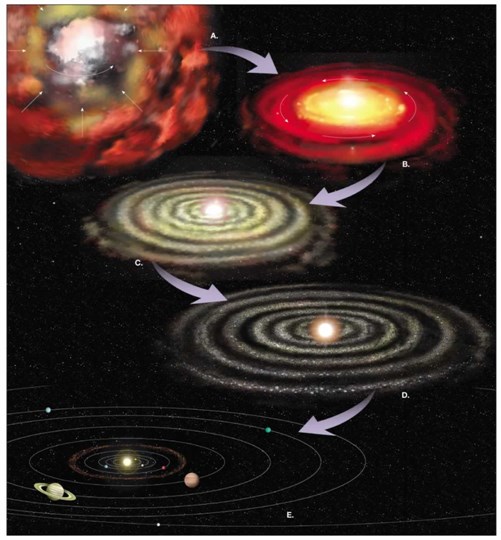The nebular theory is often called as an explanation for the formation of solar systems.
The word “nebula” is Latin for “cloud”. According to the explanation, stars are born from clouds of interstellar dust and gas.
The theory says transition from an undifferentiated cloud to a star system complete with the planets and moon would take around 100 million years.
The solar system formed about 4.6 billion years ago, and others are also forming today in distant nebulae, according to the theory.
The nebular hypothesis is based on an idea that spinning cloud of dust, called a nebula, which flattened into a proto-planetary disk, became a solar system consisting of star with some orbiting planets.
It has also been said that the spinning nebula collected the majority of the material in its center. This is because the sun accounts for over 99 percent of the mass in the solar system.
With the formation of our solar system, the nebular cloud of the dispersed particles later developed distinct temperature zones.
The temperatures were so high close to the center, allowing only the condensation of metals and silicate minerals with very high melting points.
Explaining the theory
The nebular theory explains three observable facts: Firstly, the planets rotate in the same direction.
Second: They all orbit within 6 degrees of a common plane.
Third: All the terrestrial planets that are those within the orbit of Asteroid Belt, are rocky, while planets outside it are gaseous.
The theory further explains the existence of the Kuiper Belt, which is a region on the fringes of our solar system with a very high concentration of comets.
Star is born
The nebular theory says a solar system begins when an interstellar cloud that contains around 25 percent helium, 75 percent hydrogen, and traces of other elements, forms areas of higher concentration, or sometimes clumps.
As these clumps grow, the gravitational forces increase and are converted to the kinetic energy of the fast-moving particles that collide with one another to generate heat.
One clump dominates eventually, and as its temperature reaches some 10 million degrees Kelvin, nuclear fission begins.
This outward pressure made by the fission reactions prevents collapse, and the clump of burning hydrogen gas stabilizes to become a star.









Comment